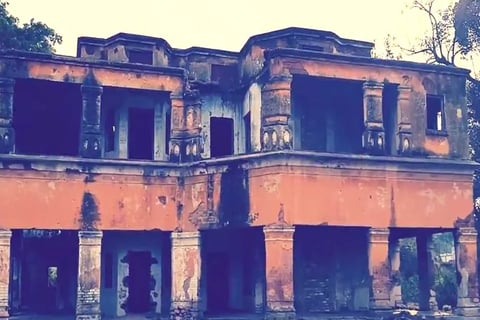This website is available in Hindi or English language
Meerut. The bungalow located in GP block of Meerut is also included in the 10 most scary places of the country. Dainikbhaskar.com tried to know the truth of the story of this haunted bungalow from the words of the watchman there. If the watchman is to be believed, the soul of an English inspector roams in this haunted bungalow. The inspector had died in an accident...
- Regarding this bungalow located in GP block, Shravan, who was the watchman there, told that his father used to live there with his family and work as a watchman. One day, the inspector D'Souza died in an accident at the nearby Company Bagh intersection. A few days after that, people started seeing a ghost. About which it was said that this is the soul of the inspector D'Souza.
- Shravan told that his father Sohanlal came and settled here in 1945. Later, when the country became independent, the English family vacated this bungalow and left. After their departure, whoever came to live in this bungalow got scared of the presence of a ghost in it. After which this bungalow became empty and now it is known as haunted bungalow.
- Shravan is also now living at a different place away from this bungalow. Now no one likes to go to this bungalow. Dense bushes have grown around the bungalow. Being in the Cantt area, the entry of common man is prohibited here anyway.
D'Souza's soul used to demand bread-butter and eggs
- People say that the soul of D'Souza, who was wandering at that time, used to demand bread-butter and eggs from people. People going to work early in the morning used to leave bread-butter or eggs at the crossroads out of fear. People did not look back after keeping the goods at the crossroads. Later these goods were found missing from there. However, now no one comes on this route.
These are also the stories about this bungalow
- It has also come to light about the bungalow that a woman wearing a red colored sari is seen here. Some people say that four boys were seen drinking beer in the light of candles inside the bungalow. Due to all kinds of rumours, people stopped going to this bungalow.
Shravan's father had come from Punjab
- Shravan Kumar, who was the watchman of the bungalow known as the haunted bungalow, says that his father came here from Punjab in 1945. After his father, he used to guard the bungalow. The British left after independence.
- Only after his departure, stories of ghosts started coming to the fore. However, Shravan says that he has never seen any spirit here.
This is what they say
- Historian Dr. KK Sharma says that there is no official confirmation of the rumours about the haunted bungalow. All are based on fabricated rumours.
- Dr. Manoj Gautam, the President of the State Museum, says that there is no historical proof about this. People talk, but there is no eyewitness.
- Social worker Sheelendra Kumar says that he has definitely heard about this, but there is no concrete proof. It is possible that after the British left, this mansion was left empty and slowly turned into ruins and people started making up stories about it.
- Sunil Taneja says that at that time, people living around this place used to talk about seeing something like a shadow, but no one confirmed it.
### GP Block, Meerut: Timings and Overview
GP Block originally used to be the seat of various administrative activities but now comprises of key government offices and acts as a reminder to the rich culture the town possesses.
Timings
As the GP Block is a government office building, it does not have exact visiting hours as found in most of the tourist destinations. It is, however, normally accessible to the public on normal working days of the week, from 9:00 AM to 5:00 PM, from Mondays to Fridays. Visitors who want to see the building and take photos of it can do so anytime. For anybody interested in the how and the why of the building, actually going inside it, must be done preferably on weekdays when staff members of the government are present and may be willing to talk about the place.
### Historical Significance
The old tale attached to GP Block includes numerous other things than just the architectural beauty. Though the block was constructed in the late nineteenth century, the brief history of the building is inextricably linked to lot of events of historical significance that comprised the history of Meerut. This included the Revolt of 1857, hailed as the First War for Independence in India. Since it wasduring the uprising that she became well known, the existence of such a great building in that chaotic era enhances her history even more.
The layout of the building also displays elements of British colonial architecture, which is usually characterized by tall ceilings, wide corridors and big sized windows. Every minutiae of the structure speaks volumes of the painstaking work that has gone into the beautiful endless designs and patterns within the structure. The GP Block was not only a place of office but a center of various political pursuits in a crucial period of Indian history.
Architectural Heritage
GP Block is characterized by the unique capacity of incorporating disparate architectural designs, owing to the presence of Mughal and Gothic features within the very same structure. The building is made of red brick which is both artistic and solid. Some of the features found in the block are pointed arches, intricate cornices, and large verandah designed to allow light and air to flow in.
Facade of GP Block is one of its most impressive features decorated with a variety of designs and patterns. Central to the block is a large clock tower that acts as the main feature of the block, embodying progress and direction, and reminding all of the importance of time and the history of the place.
The region around is also attractive with green lawns and well-maintained gardens although busy city life prevails outside. These areas are used for some public functions and social purposes which add value vocation relevance to GP Block at Meerut.
Visiting Experience
One great thing about visiting GP Block is an experience that allows one to delve into Meerut’s past. Though the structure in itself is largely an office, its parapets and gardens offer much to explore and ponder over. Many tourists are enchanted by the architectural motifs and take picture that help to understand the importance and attractiveness of this place.
The local population participates in great numbers, which contributes to the effervescence of this part of the city. Since GP Block is located near several other historical sites and busy marketplaces, it is possible to venture across the cultural geography of Meerut. Concerned patients can also include a visit to GP Block along with the Suraj Kund and the earlier established Shahid Smarak, allowing a full course of engagement.
In summary,
In the end, GP Block at Meerut is an outstanding structure and an evidence of the city’s historical and architectural richness as well. The center mostly serves as a government structure yet its importance goes way beyond the administrative functions. It opens its doors to those interested in visiting it during the working hours, allowing them to enjoy its beauty and appreciate its contribution in the history of India.
As tourists examine the block and its precincts, Meerut strikes them as a place full of stories. Because of its architectural brilliance and historical context, GP Block is not only appended in the catalog of Delhi attractions; it is an essential frontier for all those who wish to uncover the mystery that is the cultural legacy of the city. GP Block must, however, be more than a simple structure. It is a dynamic factor in history that reaches out to generations and provokes them almost fatalistically, embodying the active willingness of society, which in this case has a particular primary feature, namely, the city that was so important in the independence of India.
GP Block,Meerut


